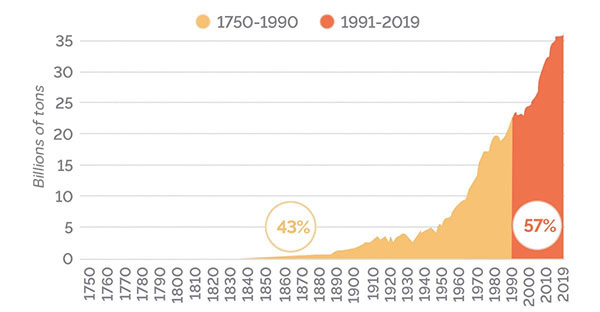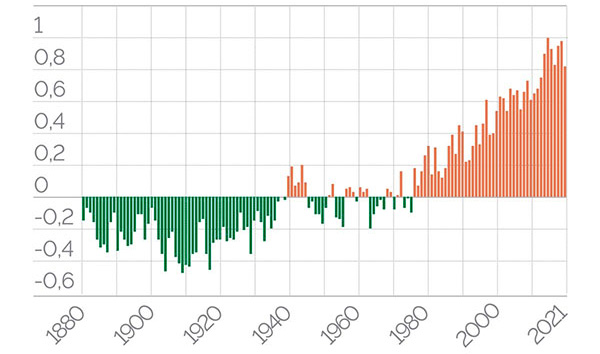In the summer of 2023, headlines have been made by worrying weather events, such as soaring temperatures in many Southern European locations, or the violent storms and adverse weather events that have hit hard several regions of central Europe. These extreme weather events heighten the risk of wildfires and hydro-geological instability, that ultimately have a negative fallout on the economy as well.
Over the past few days, a large group of Italian scientists, with Nobel Prize winner Giorgio Parisi among them, have co-signed an open letter to the Italian media to further raise public awareness: “This is not just bad weather, these are the effects of climate change”.
But what is climate change? From a scientific point of view, climate change is a persistent and long-term change in weather conditions. Climate change is mostly caused by greenhouse gases (GHG) that accumulate in the atmosphere, of which carbon dioxide (CO2) is the most common. These gases contribute to the greenhouse effect, and act as an insulant around the planet, causing an increase in the average temperature of the atmosphere over both land and water. The United Nations Framework Convention on Climate Change defines climate change as a change in climate explained directly or indirectly by human activity, that alters the composition of the global atmosphere and which is in addition to the natural climate variability observed over comparable time periods.
Regrettably, climate science is not yet able to exhaustively understand the effects of climate change, mostly because the phenomenon interacts with other factors, making it hard to isolate causes and effects. Furthermore, there is a lack of historical data (before today, human beings have never experienced an environment in which the concentration of CO2 in the atmosphere exceeds 400 parts per million), which means it is no easy task for scientist to build model scenarios of the potential future evolution of global temperatures.
In any case, important steps are being made in terms of building up fresh knowledge and conducting analyses, that are put to use in drawing up estimates of the impact on GDP: “Measures based on GDP can capture the effects of the increase in average temperatures focusing on mechanisms such as the change in productivity, investment, and labour supply”.
To this end, the Bank of Italy has recently published and interesting paper on the long-term economic impact of rising temperatures in Italy. The paper, entitled "Dinamica delle temperature e attività economica in Italia: un’analisi di lungo periodo” (Dynamics of temperatures and economic activity in Italy: a long-term analysis) and wrote by Michele Brunetti, Paolo Croce, Matteo Gomellini and Paolo Piselli, focuses in particular on the impacts on per capita GDP of the increase of temperatures in Italy by Province, in the course of the 20th century.
Since the beginning of the 20th century, the average temperature of the surface of the Earth has increased at unprecedented speed, and most scientists agree that global temperatures are destined to rise further (Source: IPCC, 2021).
Annual global CO2 emissions

Source: Our World In Data
Many simulations suggest that, unless mitigation actions are put in place, future temperature increases could progressively lead to a significant contraction of GDP, due to direct or indirect effects (for instance commodity price increases): “The increase in temperatures may have direct negative effects on national product through a wide range of channels, such as the contraction of agricultural produce, the reduction of worker productivity, and declining investment in the sectors most exposed to the consequences of global warming”. As the authors of the paper point out, the estimates provided are conservative, as they include the direct negative effects of the increase of temperatures on national product, but not the effects that derive from extreme weather events (natural disasters, increase in mortality, deterioration of health, migration). Furthermore, the loss of “stock” (damage to buildings, land, and infrastructures) is not explicitly considered.
Global average surface temperature (in °C)

Source: National Oceanic and Atmospheric Administration
In the absence of mitigation measures, “a large number of papers prove that temperature increases negatively affect the economy in both developing and advanced countries, and impact different business sectors and the main economic variables (…) also affecting individual cognitive functions and human health”. Many simulations suggest that the advanced regions of the world will suffer a sharper rise in average temperatures going forward than the 1.5 °C increase optimistically forecast by 2100. Temperatures could in fact increase at the global level roughly by between 0.5 and 1 °C, with a worst-case scenario under which the global temperature could rise by up to +4.5 °C (SSP - Shared Socioeconomic Pathways, IPCC).
“Average temperatures in Italy have increased by around 2 °C since the beginning of the last century, with essentially equal growth trends across territories. The increases have had a negative impact on per capita GDP growth, that accentuated at the end of the 1900s in step with the rise of temperatures in the 1981-2001 period”. Based on the analyses carried out by the authors of the Bank of Italy paper, “an emissions scenario with temperature increases by +1.5 °C as at 2100 could hold back per capita growth, by between 0.04 and 0.13 per cent annual, ultimately resulting at the end of the century in slower growth by 2.8 and 9.5 per cent compared to the level that would prevail if it were to progress in line with its historical trend”.
The Bank of Italy’s document indicates the range of the possible cost of a failure to complete the transition: it is up to us to put in place emissions mitigation and reduction actions before it is too late.
Disclaimer:
Nothing in this document is intended as investment research or as a marketing communication, nor as a recommendation or suggestion, express or implied, with respect to an investment strategy concerning the financial instruments managed or issued by Eurizon Capital SGR S.p.A.. Neither is this document a solicitation or offer, investment, legal, tax or other advice.
The opinions, forecasts or estimates contained herein are made with reference only to the date of preparation, and there can be no assurance that results or any future events will be consistent with the opinions, forecasts or estimates contained herein. The information provided and opinions contained are based on sources believed to be reliable and in good faith. However, no representation or warranty, express or implied, is made by Eurizon Capital SGR S.p.A. as to the accuracy, completeness or fairness of the information provided.
Any information contained in the present document may, after the date of its preparation, be subject to modification or updating.







